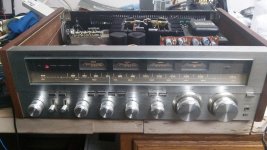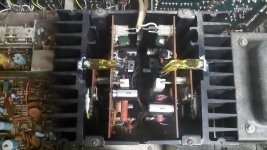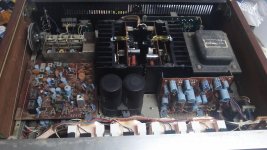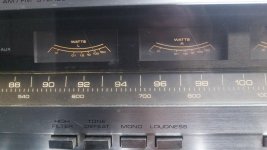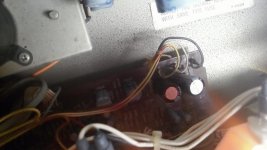I have to correct something, original bias was 30mV 60mA not 30mA, late typo
Now set to 40mV 80mA (varies around 39-41mV approx)
I will leave the amplifier on all day tomorrow to keep it warmed up for a long period of time, and check the bias again.
Now set to 40mV 80mA (varies around 39-41mV approx)
I will leave the amplifier on all day tomorrow to keep it warmed up for a long period of time, and check the bias again.
When I worked at the Radio Shack service department, we had of course service manuals for all the products. One thing I noticed quite routinely is that the bias specs were nominal- sometimes the result of the factory spec was some crossover distortion at low power levels or maybe not, depending on the individual unit.
As a result I took to adjusting the bias by using a sine wave and viewing the result on a 'scope, to tune out the crossover notch. IOW, when I was done they ran with more bias in many cases, but I never had one that overheated or anything like that. They were marginally warmer at idle is all, but they sounded better and I even got feedback comments from customers.
This is just FWIW; obviously YMMV due to components used in the amp. But it was pretty obvious that Radio Shack didn't spend as much time with the gear getting the most out of it, which apparently was part of their price strategy. Another example of that was the FM tuner specs. Often in some receivers the exact same tuner board was used as in a Pioneer or Kenwood which both had better sensitivity specs. I found that just by giving the tuner an alignment I could easily meet or exceed the specs of the more expensive brands. Many of the Realistic branded models were made by Trio, which was involved with Kenwood.
As a result I took to adjusting the bias by using a sine wave and viewing the result on a 'scope, to tune out the crossover notch. IOW, when I was done they ran with more bias in many cases, but I never had one that overheated or anything like that. They were marginally warmer at idle is all, but they sounded better and I even got feedback comments from customers.
This is just FWIW; obviously YMMV due to components used in the amp. But it was pretty obvious that Radio Shack didn't spend as much time with the gear getting the most out of it, which apparently was part of their price strategy. Another example of that was the FM tuner specs. Often in some receivers the exact same tuner board was used as in a Pioneer or Kenwood which both had better sensitivity specs. I found that just by giving the tuner an alignment I could easily meet or exceed the specs of the more expensive brands. Many of the Realistic branded models were made by Trio, which was involved with Kenwood.
As a result I took to adjusting the bias by using a sine wave and viewing the result on a 'scope, to tune out the crossover notch. .
I have designed quite a few of my own class AB amplifiers.
I always used the signal generator and scope method myself and always got good results.
This gives minimum crossover distortion at a minimum bias current.
Peavey were also into minimal bias currents in their amps.
I also upgraded capacitors in the power supply input on the Tone Control Preamp board. This section is what directly feeds the signal into the power amp input.
It originally has large old-school Nichicon 25V 220uf capacitors for the rails. I upgraded them to Nichicon 2200uf 25V 105C and this made a nice improvement. The new caps were the same diameter, but only slightly taller. Bass was noticeably clearer, but overall tone bass-treble sounds better. Slightly less distortion at mid-higher volumes. Customer should be pleased.
Amp runs cool, bias is stable, cleaned all pots and switches to remove crackle, upgraded caps in preamp, now sounds good.
It originally has large old-school Nichicon 25V 220uf capacitors for the rails. I upgraded them to Nichicon 2200uf 25V 105C and this made a nice improvement. The new caps were the same diameter, but only slightly taller. Bass was noticeably clearer, but overall tone bass-treble sounds better. Slightly less distortion at mid-higher volumes. Customer should be pleased.
Amp runs cool, bias is stable, cleaned all pots and switches to remove crackle, upgraded caps in preamp, now sounds good.
Last edited:
Hi all,
Since this is a repair for a customer, there is an entirely different level of responsibility involved. From reading the past posts I have severe reservations about this repair job.
Without the basic instruments required for this work, the job should never have even been attempted. No oscilloscope is a job killer right off the bat. Without a distortion analyzer, no work on the output stage should have been started. I'm sorry for my stance on this, but there have been errors made in this repair.
The factory bias current is always set well high of what is required, never too low. With matched parts (complimentary drivers and outputs), the minimum bias current is typically in the 5 to 10 mA range. If it isn't, something is wrong. Obviously a transistor checker is required as well here. One that also tests for leakage and beta.
The last capacitor replaced was done improperly. The original value should have been used, or maybe 330 uF. Going to 2,200 uF is irresponsible and may in the future destroy that regulator. The raw supply capacitor must always be larger than the smaller output filter capacitors. Now every time you turn this unit off, that supply will discharge through the transistor due to reverse emitter-base breakdown. It may not occur today, but it very likely will in the future.
The power supply is the one place that should have all the capacitors replaced for certain. They run at higher temperatures and have ripple current that flows through them all the time when the set is running. The main filter caps are often perfectly fine.
EWorkshop1708, DIY on your own equipment is one thing as long as you don't sell it to someone else, but working on equipment for a paying customer is one thing you not qualified to do. I'm not insulting you, I am pointing out that you need real training to gain insight as to how amplifiers really work. Don't feel bad, many technicians these days don't either. The real killer - you do not have the equipment required to do this work. If you aren't going to invest in a half decent oscilloscope, you do not even have the proper mindset to embark on fixing other people's equipment.
I have seen horrible technicians who have worked for +25 years in this field. They wreck equipment and it actually runs for longer than it should. Every single one was convinced of their above average skill in repairs. They all have in common one thing. They normally do not have the equipment to perform the work, or their equipment is broken but they don't care. That coupled with a lack of understanding how the parts they use work. Many also use replacement brand components (ECG, NTE - whatever), or buy their parts off Ebay. You can't do that, morally speaking.
If you have some years under your belt doing this I don't see you changing, and that is sad. Equipment will speed up your diagnostic time and confirm some problems have been corrected. Proper component testers would give you a better answer as to whether a capacitor or resistor is good. Some training and applied common sense will help point the way when performing a repair. One thing you are doing that is correctly is changing outputs and driver transistors. That's great. Maybe all you really need to become a very good technician is some mentoring locally, and that test equipment that you absolutely do need. If you can't see yourself doing that, please do not take in any repairs from customers. No matter how you try and justify doing paid repairs, you're lying to yourself. You need these things - and probably more.
I'm not attacking you. I am pointing out those things I see that need improvement. I would like to see you improve and become capable of executing a great job.
-Chris
Since this is a repair for a customer, there is an entirely different level of responsibility involved. From reading the past posts I have severe reservations about this repair job.
Without the basic instruments required for this work, the job should never have even been attempted. No oscilloscope is a job killer right off the bat. Without a distortion analyzer, no work on the output stage should have been started. I'm sorry for my stance on this, but there have been errors made in this repair.
The factory bias current is always set well high of what is required, never too low. With matched parts (complimentary drivers and outputs), the minimum bias current is typically in the 5 to 10 mA range. If it isn't, something is wrong. Obviously a transistor checker is required as well here. One that also tests for leakage and beta.
The last capacitor replaced was done improperly. The original value should have been used, or maybe 330 uF. Going to 2,200 uF is irresponsible and may in the future destroy that regulator. The raw supply capacitor must always be larger than the smaller output filter capacitors. Now every time you turn this unit off, that supply will discharge through the transistor due to reverse emitter-base breakdown. It may not occur today, but it very likely will in the future.
The power supply is the one place that should have all the capacitors replaced for certain. They run at higher temperatures and have ripple current that flows through them all the time when the set is running. The main filter caps are often perfectly fine.
EWorkshop1708, DIY on your own equipment is one thing as long as you don't sell it to someone else, but working on equipment for a paying customer is one thing you not qualified to do. I'm not insulting you, I am pointing out that you need real training to gain insight as to how amplifiers really work. Don't feel bad, many technicians these days don't either. The real killer - you do not have the equipment required to do this work. If you aren't going to invest in a half decent oscilloscope, you do not even have the proper mindset to embark on fixing other people's equipment.
I have seen horrible technicians who have worked for +25 years in this field. They wreck equipment and it actually runs for longer than it should. Every single one was convinced of their above average skill in repairs. They all have in common one thing. They normally do not have the equipment to perform the work, or their equipment is broken but they don't care. That coupled with a lack of understanding how the parts they use work. Many also use replacement brand components (ECG, NTE - whatever), or buy their parts off Ebay. You can't do that, morally speaking.
If you have some years under your belt doing this I don't see you changing, and that is sad. Equipment will speed up your diagnostic time and confirm some problems have been corrected. Proper component testers would give you a better answer as to whether a capacitor or resistor is good. Some training and applied common sense will help point the way when performing a repair. One thing you are doing that is correctly is changing outputs and driver transistors. That's great. Maybe all you really need to become a very good technician is some mentoring locally, and that test equipment that you absolutely do need. If you can't see yourself doing that, please do not take in any repairs from customers. No matter how you try and justify doing paid repairs, you're lying to yourself. You need these things - and probably more.
I'm not attacking you. I am pointing out those things I see that need improvement. I would like to see you improve and become capable of executing a great job.
-Chris

The amp is fixed, and although advice has been offered from different sources the thread has just degenerated into a free for all slanging match.
21 posts have been deleted. Any further unpleasantness will see points and penalties handed out.
Edit... this thread is now closed.
- Status
- Not open for further replies.
- Home
- Amplifiers
- Solid State
- Unstable Bias Realistic STA-2080
